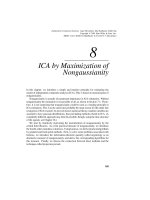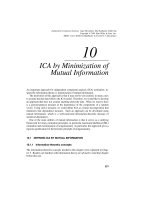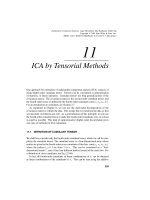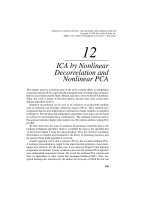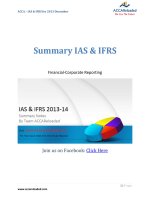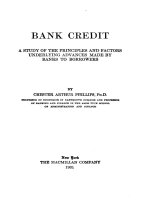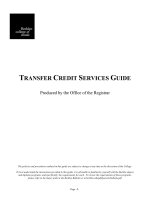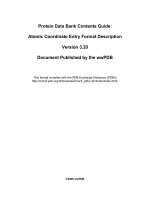YTC scalper by lance beggs
Bạn đang xem bản rút gọn của tài liệu. Xem và tải ngay bản đầy đủ của tài liệu tại đây (8.26 MB, 232 trang )
Adapting the
YTC Price Action Trader
to Lower Timeframes
YTC Scalper
by Lance Beggs
Published by:
LB68 Publishing Pty Ltd
PO Box 4097
Kirwan QLD 4817
Copyright © 2011. Lance Beggs. All rights reserved.
No part of this publication may be reproduced or transmitted in any form or by any means,
electronic or mechanical, without written permission from the publisher, except as permitted by
Australian Copyright Laws.
First Edition, 2011.
V1.07
Published in Australia.
Disclaimer
If you continue to browse and use this document, you are agreeing to comply with and be bound by the legal notices
of the publisher, LB68 Publishing Pty Ltd. These legal notices will be found at our primary website,
YourTradingCoach.com:
Disclaimer - />Terms and Conditions - />Privacy Policy - />All references to this document and the content within refer to not only this document but also to all associated and
related courses, products, services and webpages, and all mediums of communication including text, video, audio
and image.
This document is for educational and general informational purposes only and nothing contained on it is or is
intended to be construed as advice. It does not take into account your individual objectives, financial situation or
needs. It should not be used, relied upon or treated as a substitute for specific or professional advice. You should,
before you act or use any of this information, consider the appropriateness of this information having regard to your
own personal objectives, financial situation and needs. You should obtain your own independent professional advice
before making any decision based on this information and you agree that you use this document and all related
content at your own risk.
The information in this document is general in nature only. It should not be your only source of information but
should be treated as a guide only. We make no representations, promises, warranties or guarantees regarding any
positive impact on your business including revenue or otherwise.
The content of this document has been prepared by LB68 Publishing Pty Ltd on the basis of information and sources
believed to be reliable. While we endeavor to keep the information up-to-date and correct, we make no
representation or warranties of any kind, express or implied, about the completeness, accuracy, reliability or
suitability with respect to the information contained in this document for any purpose. Any reliance you place on
such information is therefore strictly at your own risk.
In no event will we be liable for any loss or damage including and without limitation, indirect or consequential loss
or damage, or any loss or damage howsoever arising from loss of data or profits arising out of, or in connection with
the use of this document.
Reference to any market, trading timeframe, analysis style or trading technique is for the purpose of information and
education only. They are not to be considered a recommendation as being appropriate to your circumstances or
needs.
All charting platforms and chart layouts (including timeframes, indicators and parameters) used within this
document are being used to demonstrate and explain a trading concept, for the purposes of information and
education only. These charting platforms and chart layouts are in no way recommended as being suitable for your
trading purposes.
Charts, setups and trade examples shown throughout this document have been chosen in order to provide the best
possible demonstration of concept, for information and education purposes. They were not necessarily traded live by
the author.
Through this document you may be able to link to other websites which are not under the control of LB68
Publishing Pty Ltd. We have no control over the nature, content and availability of those websites. The inclusion of
any links does not necessarily imply a recommendation or endorse the views expressed within them.
U.S. Government Required Disclaimer:
Futures Trading and Options trading has large potential rewards, but also large potential risk. You must be aware of
the risks and be willing to accept them in order to invest in the futures and options markets. Don't trade with money
you can't afford to lose. This is neither a solicitation nor an offer to Buy/Sell futures or options. No representation is
being made that any account will or is likely to achieve profits or losses similar to those discussed on this web site.
The past performance of any trading system or methodology is not necessarily indicative of future results.
CFTC RULE 4.41 - HYPOTHETICAL OR SIMULATED PERFORMANCE RESULTS HAVE CERTAIN
LIMITATIONS. UNLIKE AN ACTUAL PERFORMANCE RECORD, SIMULATED RESULTS DO NOT
REPRESENT ACTUAL TRADING. ALSO, SINCE THE TRADES HAVE NOT BEEN EXECUTED, THE
RESULTS MAY HAVE UNDER-OR-OVER COMPENSATED FOR THE IMPACT, IF ANY, OF CERTAIN
MARKET FACTORS, SUCH AS LACK OF LIQUIDITY. SIMULATED TRADING PROGRAMS IN GENERAL
ARE ALSO SUBJECT TO THE FACT THAT THEY ARE DESIGNED WITH THE BENEFIT OF HINDSIGHT.
NO REPRESENTATION IS BEING MADE THAT ANY ACCOUNT WILL OR IS LIKELY TO ACHIEVE
PROFIT OR LOSSES SIMILAR TO THOSE SHOWN
Copyright Notice
The contents of this document are the copyright of Lance Beggs. © 2011. All rights reserved.
Any redistribution or reproduction of part or all of the contents in any form is prohibited other than the following:
you may print or download contents to a local hard disk for your personal and non-commercial use only. You may
copy some extracts only to individual third parties for their personal use but only with our express permission.
You may not, except with our express written permission, distribute or commercially exploit any of the content. You
may not transmit it or store it on any other website or other form of electronic retrieval system.
Affiliate Sales
If you find this ebook to be of great value and wish to offer it for sale to your own customers or website/blog
readers, I encourage you to sign up as an affiliate.
More information, including details on affiliate commissions, is listed at the following webpage:
/>
About the Author
Lance Beggs is a full time day-trader with a current preference for FX futures and E-mini futures
markets. His style of trading is discretionary, operating in the direction of short-term sentiment
within a framework of support and resistance.
As an ex-military helicopter pilot and aviation safety specialist, Lance has an interest in applying
the lessons and philosophy of aviation safety to the trading environment, through study in human
factors, risk management and crew resource management.
He is the founder and chief contributor to , which aims to
provide quality trading education and resources with an emphasis on the ‘less sexy’ but more
important aspects of trading – business management, risk management, money management and
trading psychology.
Lance can be contacted via
“Success is the sum of small efforts –
repeated day in and day out.”
…Robert Collier
Table of Contents
Part One - Introduction
Chapter One – Introduction……………………………………………………………….
1.1 – Welcome…….………………………………………………………………...
1.2 – Prerequisites………………………………..………………………………….
1.3 – Scope………………………………………………………………………….
1.4 – Acknowledgments..…………………………………………………………...
1.5 – Feedback………………………………………………………………………
1.6 – Contents Overview…………………………………………………………….
11
12
12
12
14
15
15
Chapter Two – My Trader Evolution…………………………………………………….
2.1 – My Trader Evolution………………….………………………………………
2.2 – What Does This Mean For You? ……………………………………………..
17
18
19
Chapter Three – Scalping………………………………………………………………….
3.1 – What Do I Mean By Scalping? ………………….……………………………
3.2 – Advantages……..…………………………………………..…………………
3.3 – Disadvantages……..…………………………………………..………………
3.4 – Scalping vs Longer Timeframe Trading..…………………..…………………
20
21
24
25
26
Part Two – The Indecisive Trader
Chapter Four – Trading is a Decision Making Process………………………………….
4.1 – Further Exploration of Market Uncertainty..………………………………….
4.2 – Why Are We Studying Decision Making? .………………..…………………
4.3 – The Decision Making Model……………. .………………..…………………
4.3.1 – The Environment.……..……………………………………………..
4.3.2 – Situational Awareness..……………………………………………...
4.3.3 – Decision………….……..……………………………………………
4.3.4 – Action…………….……..……………………………………………..
4.3.5 – Repeat…………………..……………………………………………
4.4 – Quick Summary of the Decision Making Model.………………..……………
28
29
29
33
34
34
39
44
44
44
Chapter Five – The Conflicted Trader……………………………………………………
5.1 – You Don’t Trust Your Own Analysis…………………………………...…….
5.2 – Competing Needs…………………………………………..…………………
5.3 – The Conflicted Trader…….………………………………..…………………
46
47
50
52
Chapter Six – The Indecisive Trader……………………………………………………..
6.1 – How YTC PAT Helps Us Operate In The Market Environment……………..
6.2 – The Unique Challenge of Scalping Timeframes.…………...………………...
6.3 – How We Respond to Information Overload…...…………..…………………
6.4 – The Indecisive Trader…………………………..…………..…………………
53
54
55
56
59
Part Three – The Decisive Trader
Chapter Seven – The Decisive Trader…………………………………………………….
7.1 – Trading Success Requires Decisive Action..………………………………….
7.2 – Being Decisive Is More Important Than Being Right………………………...
62
63
65
Chapter Eight – Simplification……………………………………………………………
8.1 – Simplicity……….………………….………………………………………….
8.2 – Simplicity – From a Business Perspective……………………………………
8.2.1 – Market Selection and Session Timings………………………………
8.2.2 – Minimise Information - Clean Charts……..………………………...
8.2.3 – Minimise Information – Candles vs OHLC bars…….……………...
8.2.4 – Simpler Routines - During Session…….……………………………
8.2.5 – Tracking Results..……..……………………………………………..
8.2.6 – Simpler Execution – Chart Trading vs DOM..……………………..
8.3 – Simplicity – From a Strategy Perspective…………………………………….
8.3.1 – Concept...............................................................................................
8.3.2 – Analysis Remains the Same…………..……..……………………….
8.3.3 – YTC Scalper Simplification – Part One……………….…………….
8.3.4 – A Different Market Model……………………………….…………..
8.3.5 – Building the Scalping Channel………………………………………
8.3.6 – YTC Scalper Simplification – Part Two……………….…………….
8.3.7 – Summary of Concept……………………………..…………………
8.3.8 – Examples – Entry and Trade Management…...……………………..
66
67
67
67
68
70
72
75
76
77
77
77
79
80
86
89
112
114
Chapter Nine – Additional Considerations……………………………………………….
9.1 – Market Internals…...……………….………………………………………….
9.1.1 – NYSE Tick……………………………….…………………………..
9.1.2 – How I Display NYSE Tick……..……………………………..……...
9.1.3 – How I Use NYSE Tick……………………………...…….………….
9.1.4 – An Example of NYSE Tick Supporting Analysis...…………………..
9.2 – Gap Opens…………………………………………………………………….
9.2.1 – How I Manage Gap Opens………………………………………….
9.3 – Slow Action……………………………………………………………………
118
119
119
121
124
129
131
131
136
9.3.1 – Quiet Markets……………..…………………………………………
9.4 – Highly Volatile Action………………………………………………………..
9.4.1 – Managing Post-News Speed…………………………………………
9.4.2 – Market Fear / High Volatility………..……..……………………….
9.5 – Using Alternate Lower Timeframes…………………………………………..
9.5.1 – Alternate Range Chart Settings..……………………………………
9.5.2 – Tick Charts……………………………..……..…………………….
9.5.3 – Alternate Lower Timeframe Template…………...…….……………
9.5.4 – Multiple Lower Timeframe Charts.………………………………….
9.5.5 – Time Charts……..……..…………………………………………….
136
140
140
141
144
144
146
148
154
154
Chapter Ten – Trade Examples…………………………………………………………...
10.1 – E-mini Russell – 24th March 2011………….………………………………..
10.2 – Euro – 28th March 2011….………………………………..…………………
10.3 – A Sequence of Losses...….………………………………..…………………
10.4 – Pattern Based Entry…..….………………………………..…………………
157
159
196
209
214
Part Four – Implementation
Chapter Eleven – Implementation………………………………………………………...
11.1 – Implementation…..……………….………………………………………….
11.1.1 – Post-Session Learning…...…………………………………………
11.1.2 – Simulation………………..………………………………………...
11.1.3 – Live – Minimum Size…...…………………………………………..
11.1.4 – Live – Increasing Size……………………………..……………….
220
221
221
223
223
224
Chapter Twelve – Conclusion…………...………………………………………………...
12.1 – Final Words…..…..……………….………………………………………….
225
226
Glossary...............................................................................................................................
231
Resources............................................................................................................................
232
PART ONE
INTRODUCTION
Chapter 1 - Introduction
1.1 - Welcome
Welcome to the YTC Scalper.
The aim of this book is to discuss the implementation of the YTC Price Action Trader (YTC
PAT) methodology on shorter scalping timeframes.
Why a separate book? The fact is that the scalping environment provides some unique
considerations which are unlikely to be of interest to all traders. So, given the size of this
document, the decision was made to create it as a separate book rather than expand the size of
original YTC PAT series.
1.2 - Prerequisites
A prerequisite for reading this document is to have read and understood (and preferably traded)
the YTC PAT methodology. In particular, the YTC PAT theory of markets and analysis
techniques are considered essential prerequisite knowledge.
This book will not repeat the material contained within the YTC PAT series.
1.3 – Scope
1.3.1 - Strategy, Markets & Timeframes
The YTC PAT methodology is stated as being applicable to all markets and all timeframes,
provided they contain sufficient liquidity to allow entry and exit without significant slippage, and
provided they offer sufficient profit potential on price swings after overcoming costs.
It was demonstrated using a trading timeframe of 3 minutes, with a recommendation that it not
be applied on lower timeframes without first taking into account the additional considerations
that will be discussed in this document.
Therefore, the YTC Scalper is primarily for those traders who trade markets that do offer
sufficient liquidity and profit potential on trading timeframes less than 3 minutes.
For those who prefer longer timeframes, you will still gain significant benefit from this
information. The techniques designed for the YTC Scalper may also be applied on higher
timeframes if you prefer.
Which markets do I trade?
At the time of writing, I currently trade the YTC Scalper in the following markets:
E-mini futures: TF
FX futures: 6E
Primarily, my trading over the last six months has been on the FX futures, due to the late opening
time for the E-mini futures in my part of the world (12:30 am). And my preference has migrated
from the 6B to 6E on these lower timeframes, due to the lower ratio of commission to tick-size
(ie. lower costs).
I recommend this strategy for the most liquid FX futures and E-mini futures markets only. I have
conducted no testing in other markets such as forex or stocks. If these markets interest you,
you’ll need to conduct your own testing to confirm suitability. As mentioned earlier, your
primary concern is confirming liquidity, and profit potential on price swings after covering costs.
This is particularly the case for spot forex which typically has higher spread costs. I do not
recommend trading spot forex on these timeframes, although that may be possible with some of
the newer ECNs offering spreads at less than one pip. You’ll need to test other markets if you’re
not interested in FX futures or E-mini futures.
I use the following timeframes:
Higher Timeframe: 5 min
Trading Timeframe: 1 min
Lower Timeframe: 1 range*
* Note regarding lower timeframe: I have traded the strategy on numerous different
lower timeframes, before settling on my preferred choice of 1-range. I particularly like
this as it allows visibility of the price action at the finest level.
However, alternate timeframes and chart-types were found equally as useable. We’ll talk
more about these alternates later.
1.3.2 – Time and Sales / DOM orderflow analysis
As with the YTC PAT, the YTC Scalper involves chart-based analysis in order to assess likely
areas of orderflow.
The scope of this document does not extend to other methods of assessing orderflow on short
timeframes, such as through analysis of Time and Sales or DOM / Level II orderflow. Exclusion
of these topics is simply due to the fact that I do not trade via these methods. They are certainly
valid approaches and I encourage you to investigate them if they interest you, as they may well
offer potential in improving YTC Scalper entry and exit decisions.
1.4 - Acknowledgments
The YTC PAT acknowledged some of the many traders and trading educators who have
influenced my trading over the last decade.
For this book, I would like to acknowledge all of the readers of the YTC PAT. Your feedback
has been very greatly appreciated; and will help to shape the future directions of the whole YTC
website and suite of products.
Thanks to you, we have exciting times ahead.
Charting
Charts throughout the book have been produced using Ninja Trader (www.ninjatrader.com).
1.5 - Feedback
As with YTC PAT, feedback is greatly appreciated whether positive or negative. In fact, I
absolutely encourage feedback if you disagree with anything presented in this document. I make
no claims of being a Guru Trader who knows it all. I see myself as someone who’s perhaps been
where you are right now and who may be able to help you take the next step. I believe that noone will ever master this game; rather it provides us with a never-ending process of learning.
While I look back at my view of the markets even just five years ago, with a laugh at how naive I
was, I would similarly be delighted to look back at this work in another five years and see further
progress and growth. We can learn from each other.
Please send all feedback to:
I’d love to hear your thoughts.
1.6 - Contents Overview
The following provides a quick summary of the material to come…
Part One introduces the concept of scalping – what it means to me and why I took this journey.
Part Two delves further into the uncertainty of the markets. Not from the perspective of price
movement, as we did with YTC PAT, but from the perspective of the trader, and how he or she
makes decisions. In this part of the book we discover why my transition to scalping timeframes
proved so challenging.
Part Three provides our solution and discusses the changes required to implement YTC PAT in
the lower timeframes. Examples are shown demonstrating application of the YTC Scalper
methodology.
Part Four wraps up the book and provides a plan for the way forward; applying your newfound
knowledge in the scalping environment.
Before you begin, I recommend spending some time skimming through the book in order to
provide yourself with a bigger-picture overview and familiarize yourself with the structure of the
contents. Take note also of the short glossary at the rear of the book, which may help with
understanding my meaning of key YTC Scalper terms.
Once again though; I will stress that YTC PAT is a pre-requisite. If you have obtained a copy of
this document without first having read YTC PAT, then much of the context behind this
discussion will be missing, along with ALL the discussion of analysis and strategy. Please read
the YTC PAT ebook first in order to properly understand this YTC Scalper supplementary
document.
Enjoy!
Chapter 2 – My Trader Evolution
2.1 – My Trader Evolution
It was June 2010… and yet again my trading underwent an evolutionary change, as I made a
transition to lower timeframes.
The reason for this change was simple. I was overwhelmed with too many commitments –
family, lifestyle, trading, YTC email overload, and a long overdue promise to write the YTC
Price Action Trader (YTC PAT) ebook series.
Something had to change.
The easiest decision was for a reduction of trading timeframe, which allowed for trading in a one
to two hour session, thereby allowing several more hours per day to work on the YTC PAT
writing and editing process. My intent at the time was that this would be a temporary change and
I’d revert back to the standard 30/3/1 minute charts on completion of writing.
However, life in the markets is always full of surprises.
Firstly, I discovered that the transition was not as simple as expected. Scalping is a very different
game; and scalping timeframes offer some unique challenges. It took a while to understand these
challenges and to overcome them, as to do so required breaking down some well-established
belief systems. We’ll talk about those further throughout this book.
Secondly, I discovered a renewed passion for trading; a simpler (although equally as
challenging) process that was more enjoyable than ever before. Like all previous reductions in
timeframe, it felt again like this is where I belong.
Of course, this created a dilemma. The YTC PAT ebook series was meant to document how I
trade the markets. But the process of writing the document resulted in a change to the way I
trade.
Should I therefore re-work the YTC PAT ebook series to just incorporate the new way I trade?
After careful consideration I decided that to do so would not be wise. It would be better to first
present “How I did trade” for those who want those longer timeframes, and to then follow it up
with this new document which outlines, “How I currently trade”.
Most of all, my concern was that this new approach to the markets appears on the surface to be
so incredibly simple. Had I just presented it then I doubt many would have taken it seriously.
By presenting the YTC PAT first, it allows you to follow the same evolutionary learning path
that I followed. I believe this is important in truly understanding the beauty of this new approach.
In any case, much of the original material does not change. The theory of markets still applies, as
does the analysis process. It’s just the trading process that varies – how we enter, manage and
exit our positions; plus how we manage our trading routines and procedures.
2.2 – What Does This Mean For You?
Having built up your knowledge with the YTC PAT, I’m now going to tear some of that down.
If you want to operate in the scalping environment, you’ll need to think in a very different
manner. And like I had to, you’ll have to discard some of your beliefs about the way we profit in
the markets.
Some of you will find this a challenge. Approach it with an open mind. Don’t believe anything I
say, but instead test all concepts in the market to prove it for yourself.
Maybe like me you’ll also find a new place that feels like it’s where you belong.
I hope you enjoy this journey.
Chapter 3 – Scalping
3.1 – What Do I Mean By Scalping?
Traditionally, scalping referred to a trading approach used by market makers or other
professionals, which aimed to buy at the bid price and (almost immediately) sell at the ask price
in order to make the spread difference.
Figure 3.1 – The Common Image of Scalping – This is NOT How We Operate
That is NOT the intent with the YTC Scalper.
In recent years, the definition has expanded to include any short-term momentum trade aiming to
profit from surges in orderflow.
As the theory behind the YTC PAT trading strategy is all about finding areas of orderflow surge,
we find our strategy very applicable to the scalping timeframes.
A short scalp trade might last anywhere from seconds to maybe five minutes.
However… as with the original YTC PAT… we won’t limit ourselves to target exits. If the
market environment offers the potential for a trending market, then we will aim to keep a portion
of the trade open to take advantage of this greater move. If you can catch one that runs all day,
then that’s a bonus. It’s still a YTC Scalper trade though, because the initial premise was based
upon a short timeframe surge in orderflow.
Let’s have a look at some YTC Scalper trade examples…
Figure 3.2 – Trade Example 1
Trade 1 (above) demonstrates the standard YTC PAT PB setup long. You’ll note that the lower
timeframe chart looks a little different, via the use of range bars and channel lines.
Moving along a little in time, we come across trades 2 and 3 which also occur at standard YTC
PAT trade locations – PB long and CPB long.
Figure 3.3 – Trade Examples 2 and 3
Trades 4 and 5 below demonstrate counter-trend entry, in expectation of resistance holding.
Figure 3.4 – Trade Examples 4 and 5
The analysis which determines our bias for future-trend direction is exactly the same as YTC
PAT. What differs and why? Just the chart display and the trade entry and management
processes. But we’ll talk more about that shortly.
For now… all we need to know is that scalping refers simply to the fact that we operate on lower
timeframes. The charts were just a teaser!
3.2 – Advantages
Why would we consider lower timeframes?
Usually the trading books offer the following advantages:
Less exposure - Reduced holding times means less potential for exposure to any adverse
price movement.
More opportunity – On the standard YTC PAT timeframes you might average around 5
trades per session. On the YTC Scalper timeframes you should easily average that in one
quick 60 minute session per day.
Less dependent on large market moves – This is the old theory that it’s easier to pick up 5
ticks 10 times, than to get one 50 tick move. Opportunity can be found in more narrow
range bound markets, as well as trending markets.
And that’s all well and good. They certainly are advantages.
However, timeframe selection in my opinion is more a matter of finding the right fit for your
psychology and your lifestyle.
Here are the advantages, as I see them relating to my own personal situation:
Lifestyle:
All the markets I’m interested in trading operate at night-time. The primary
opportunity with FX futures occurs during the UK market hours, which for me
operate from 6:00 pm to 3:00 am. The E-mini futures operate in the early hours of
the morning, opening at 12:30 am and closing at 7:15 am.
Neither option allows trading a full-session without impact on lifestyle. Trading
the full UK session impacts on family life too much. Trading the full US session
leads to chronic fatigue, ultimately reducing quality-of-life in all areas.
Trading a reduced session of 1 to 2 hours allows me to fit my trading session
around my family responsibilities, while also limiting fatigue. I trade the time
period that offers the most potential market movement (as defined by the economic
calendar), which also fits best within my families plans for the evening. If I can fit
it in, I’ll trade the UK open, or the earliest of the UK / EUR news. Otherwise, I’ll
delay till the US open, the early US economic releases, or the E-mini open.
Trading the 1 minute chart still offers sufficient opportunity within that 1-2 hour
session, to satisfy my passion for trading.
Psychology:
The greatest challenge I currently face (and have for quite a while) is maintaining
focus. I seem to have a very active mind. And if it isn’t stimulated by the market
action it seems to search out any other form of distraction. This results in a lack of
focus, negatively impacting on my trading performance.
While focus is equally (if not more) critical at scalping timeframes, I find it easier
to focus for a shorter but more intense 1-2 hour session, rather than a complete 8 or
9 hour session.
In addition… it’s become clear over the years that I am a daytrader. I’m not a
longer term swing or position trader. I hate overnight exposure. I hate having open
trades when I’m not watching them. I’m a control freak… I like to be watching
and managing my trades. It’s just the way I am. There’s no point fighting it. It’s
better to find the markets and timeframes that fit my psychology, than trying to
adapt to an unsuitable environment.
My reasons for considering a scalping timeframe may differ from yours. But if you suspect that
you may be interested in shorter, more intense trading sessions, then the best way to confirm this
is to simply trial it for a period of time. You’ll know within a month whether or not the scalping
timeframes are a match for your lifestyle and your trading psychology.
3.3 – Disadvantages
The primary disadvantage is simply that, if your trading has not yet developed to provide a
positive expectancy, then you’ll be at risk of accelerating your rate of loss.
More trades, within a shorter period of time, mean that any negative mindset or emotion is more
likely to impact upon decision making for subsequent trades. Longer timeframes allow time-out
to resolve any issues. This “time-out” is not available at lower timeframes. Unless you have
developed the ability to recognise a damaging mindset, and the discipline to walk away from the
market or trade despite the emotions, you risk magnifying its effect.
